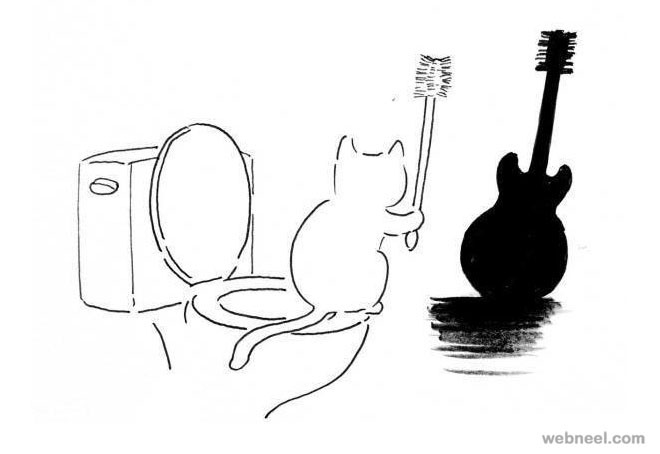Today we discussed the issue of theme, and it got me thinking... (The image makes sense by the end of the entry, I swear).
The topic of this lesson was "subject versus theme". Basically, subject is the topic or "what is the piece about? (or, "what/who is the subject?")" and theme is "what is the piece really about?" So the picture above's subject can be a cat holding a toilet scrubber, but the theme can be images/shadows being deceiving, pets creating shadows for their owners, the evilness/playfulness of cats, etc.
I quite like talking about theme. Firstly, because it's both objective (it needs to be text-based) and subjective (the interpretations can be nuanced). Secondly, because it's kind of like getting into the "essence" of the texts (if such a thing exists). Also, because the class made me think about BookTube, and how when booktubers talk about contemporary literature, they often talk about the themes of the book instead of describing the plot, because so much of it is about internal development in content and thoroughly inactive in form (case in point, Sally Rooney's entire body of work and basically most of the Women's Prize shortlists). If a a book is a 400-page exploration of a young woman going to Harvard and her summer vacations in Budapest while struggling with the birth of email and a strange romantic relationship, you have to give more than a summary when you review it. But I digress.
Let's check out some of the poems.
I want to briefly touch upon this deceiving cat poem by graveyard poet Thomas Gray, which on the surface is about a female cat who, in her attempt to eat goldfish, died drowned. It's a very biting and ironic poem, all the more because it's an ode instead of an elegy to this pseudo-favorite cat whose death the speaker recalls as a silly mishap instead of a truly sad event. BUT OH, the twist. If you read this carefully, this is actually about... you guessed it, women! The theme here, then, would be the dangers of female curiosity/greed, especially in regards to craving shiny glittering things (or even *gasp* sex!). Oh, the wonders of aesthetically pleasing misogyny since the dawn of art. Either way, the poem is fun to read and quite good in form, so I thought I'd share this nice reading of it.
Speaking of poems that are not necessarily about what they seem, take a moment to appreciate E.E. Cumming's "she being brand":
Poor naïve me, who almost quit after first handling a stick on the street, and thought: "this is so relatable, driving a new car for the first time is such a nerve-wracking experience!" But alas, this poem is not about driving at all but about a man having sex with a virgin. Women are like cars. And men have a hard time operating them. *Sigh*
So what is the theme of the entry thus far? The depth of misogyny in poetry? *Second sigh* What else is new. Formally, though, the poem is still really cool and honestly I'm still a sucker for Cummings, so let's move on to this one:
I mean, is there anyone who can be as successfully playful with language as Cummings? What in other poets might be gimmicky, in Cummings is pure joy. The jumping with the anagram in the first line, the rearranging of grasshopper into "ppegorhrass", which carries certain jumping-and-swooshing sound quality, the graphic leap, the final "become rearrangingly", to finish with the (almost literal) landing of "grasshopper"... exquisite. And content-wise, I love how the theme here can be the appreciation of the physical movement of the grasshopper as much as the way in which language is able to capture it through inventive use of its tools and certain bending of its rules.
A final shout-out to Marianne's Moore "To a Chameleon", whose form imitates the way chameleons eat, while the words themselves paint the majestic image of the chameleon itself.




No comments
Post a Comment